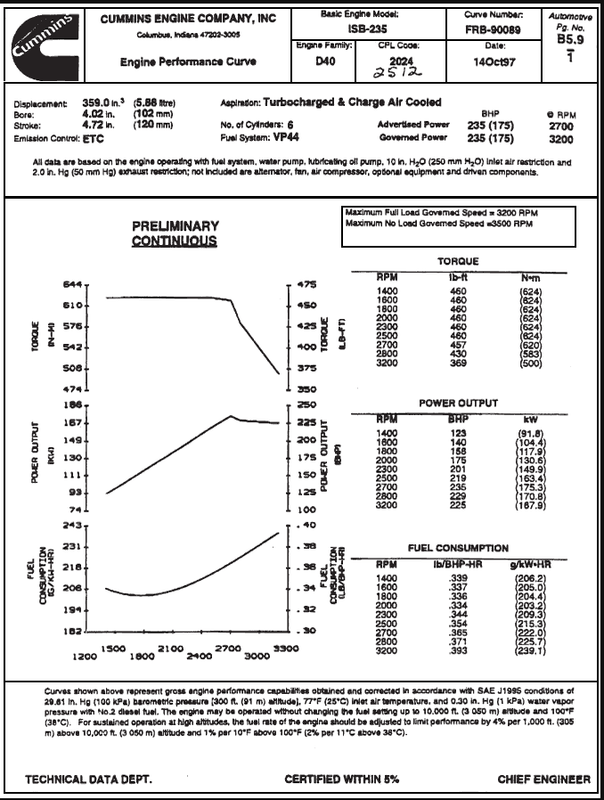ShinerBock wrote:
4x4ord wrote:
ShinerBock wrote:
4x4ord wrote:
^^^^ The thing is pulling an 18000 lb rv down the highway at 70 mph is light work. At 2000 rpm the 2020 Powerstroke can make approximately 380 HP. Even if you have an RV that requires 180 HP to tow it down the highway at 70 mph, why would you want your truck geared such that the engine revs to an rpm where it is able to produce over double the required HP? 4.30 gears are too deep for us RVers, especially when they are offering us a 10 speed transmission. If you have a 10 speed transmission and 3.55 gears and find yourself towing against a wind or in light hills and find the transmission is dropping out of 10th too often for your liking, you can simply lock out 10th gear.
The 10th gear in the 10R140 is the same as 6th in my 68RFE. I also have 3.42 gears. I get better fuel mileage if I put mine in 5th(which is about 8th in the 10R140) towing my 14k trailer. I used to tow it in 6th down to the same 160 mile route to the coast(which is mostly flat) the first few years I had the truck. About three years ago I started towing it in 5th, and my app calculated numbers fuel mileage shows that I averaged better fuel mile towing in 5th than I do 6th.
My truck can easily tow it in 6th, but I noticed that I had to put the engine under more load than I did in 6th. My fuel rail pressure pressure was much higher on average along with my EGT's and boost in 6th than 5th. Line pressure in my trans is lower to since it is not trying to keep the clutch of such a low gear together. This inturn lower trans temps.
I've never seen a brake specific fuel consumption graph that supports what you're claiming on a stock engine. Gearing up and throttling down saves fuel under light load conditions. I wonder if your aftermarket program is over fueling at low rpm and high throttle position to produce high torque at the expense of engine efficiency?
My truck was tuned withing 30k miles and towed with it for at least one year before I switched to towing in 5th. My brother also has a 2014 just like I do that was 100% as of a few weeks ago and saw the same results I did. Cummins power spec states that the 6.7L is most effeicnt between 1,800 and 2,000 rpms when towing. That is what what Cummins tuned/design the cam/turbo and rest of the engine for. Can't speak for the Powerstroke though since every engine is tuned/designed differently.
I remember Cummins used to publish this kind of data below, but I haven't seen one of these charts below(for the 5.9L) in a long time. I will try to find one for the 6.7L. I would wager it would show some similar as below.

This is very useful info but it needs to be interpreted properly. So the 5.9 was capable of achieving its best fuel economy at 2000 rpm BUT that is under heavy load. Under heavy load it was able to make 175 hp at 2000 rpm. If its fuel consumption was measured at 2000 rpm and it was only loaded to 50% of its capability it certainly would have been using more fuel than .334 lbs per hphr. I'm talking about slowing an engine down under light load conditions to improve fuel economy.
If that old Cummins had a demand on it of 80 hp, I would call that a light load, It could easily produce 80 hp at 1500 rpm and I would be willing to bet it would achieve better fuel economy producing 80 hp while running at 1500 rpm than it would running 2000 rpm with a 80 hp demand on it.
The new Powerstroke is a totally different animal. At 1600 rpm it can produce 320 HP.... 380 hp at 2000 rpm. I am saying 175 hp demand on a new Powerstroke engine qualifies as a very light load. It doesn't need anywhere near 2000 rpm to produce 175 HP. In other words 175 HP to the new Powerstroke is like 80 HP was to the old 5.9 Cummins.
And I think it is very few RVs that even require 175 HP to pull them down the highway at 70 mph. So I'll stick with my claim that 4.30 gears are not the right gears for RVers wanting a new Powerstroke. If you want a F450 for the wide front axle it is understandable but the 4.30 axle unfortunately comes with it.

